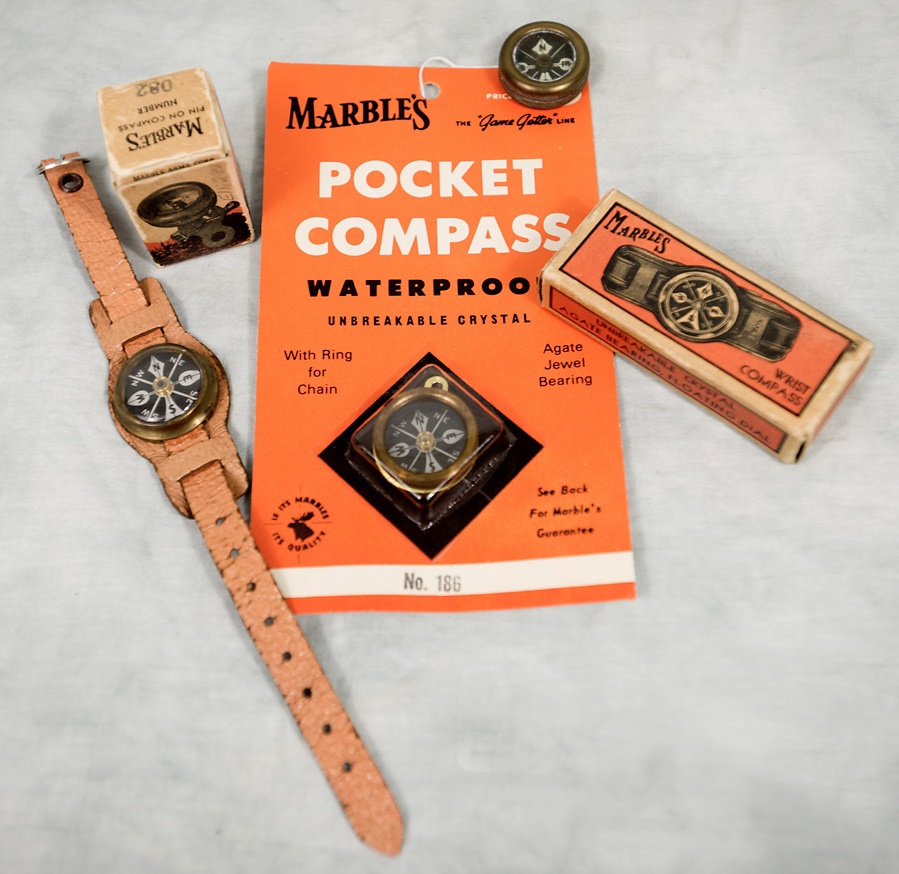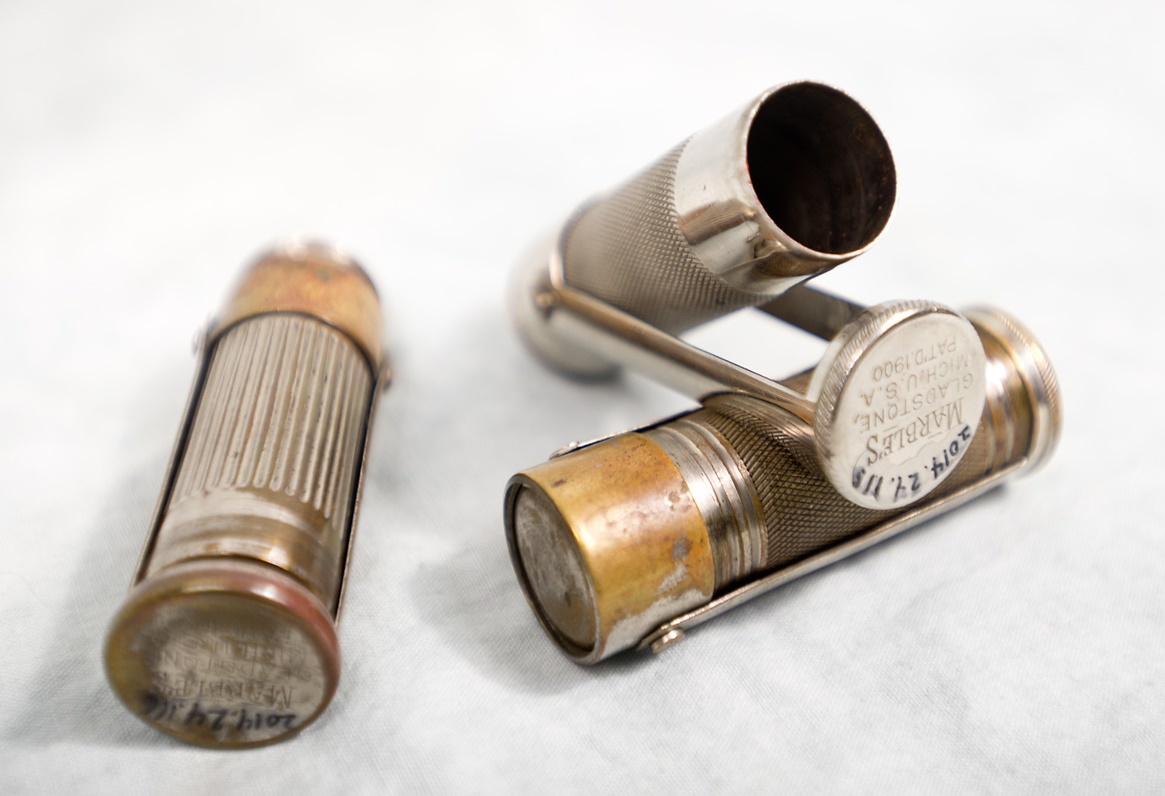Lansing museum exhibit explores the innovation, influence of early Upper Peninsula outdoorsman and inventor Webster Marble
Hundreds of thousands of deer hunters took to the Michigan woods this fall, many decked out in scent-control clothing and equipped with a smartphone, GPS unit and other gadgets.
For these modern hunters, it’s likely hard to imagine a time when outdoor gear meant simple survival necessities like a reliable compass, a well-designed knife, a safety axe or a waterproof matchbox.
The Michigan Historical Museum in Lansing invites visitors on a trip back to that time with its new exhibit, “Inventing the Outdoors” — a look at an Upper Peninsula inventor and the many outdoor products he imagined, perfected and manufactured right here in Michigan.
 Webster Lansing Marble was a surveyor and timber cruiser who had spent 20 years working in Michigan forests. Feeling the equipment available at the time (in the late 19th century) didn’t meet his needs, Marble began to experiment with ways to make improvements. Webster Lansing Marble was a surveyor and timber cruiser who had spent 20 years working in Michigan forests. Feeling the equipment available at the time (in the late 19th century) didn’t meet his needs, Marble began to experiment with ways to make improvements.
He started manufacturing outdoor tools in a workshop behind his home in Gladstone, Michigan, and by 1898 Marble had designed, prototyped and patented his first idea, the Safety Axe.
Over the next 30 years, Marble stayed hard at work, inventing new products and expanding his business, the Marble Arms and Manufacturing Co.
Before long, his Michigan-made products were known around the world, outfitting millions of hunters, anglers, campers and hikers. Marble’s goods were even used on Teddy Roosevelt's hunting trips, Robert Peary's expeditions and Charles Lindbergh's flights.
“Marble’s life’s work and his company’s impact — more than 60 patents and hundreds of innovative outdoor products — would be notable in and of themselves,” said Dennis Pace, Michigan History Foundation board member and guest curator for the Marble exhibit. “It becomes even more important when viewed through the lens of changing attitudes toward the outdoors during this historic period as America shifted from a rural to an urban society.”
Many of the exhibit’s artifacts come from a collection of Marble's products and materials that Pace donated to the museum.
“Marble built a company, a company with global reach and impact, from Gladstone, Michigan. He did this with local, rather than imported, talent,” Pace said. “He firmly believed that men and women who were active hunters, anglers and campers themselves, were best suited to produce the finest products in the world. Indeed, this proved to be the case.”
Marble’s designs for products including knives, compasses, matchboxes, axes and gun sights set the standard for the 20th-century outdoor goods market and still are influential today.
“Inventing the Outdoors” features a variety of these items, including Marble's safety folding axes, many models of hunting knives, automatic fish gaffs and more. axes, many models of hunting knives, automatic fish gaffs and more.
“The artifacts that invariably draw the longest looks from visitors are Marble’s Game Getter guns,” Pace said. “These were over/under .22/44 ball (or 410 shell) pistols with folding stocks that incorporated a host of unique features into a light, packable weapon that was useful in the field as a small-game gun, a waterfowl gun or a large-game gun.”
Pace said unfortunately these guns were deemed illegal by the Federal Firearms Act of 1935 and quickly faded into obscurity.
“They remain beautiful and practical sporting guns that incorporate much of Webster’s product philosophy and creative genius,” Pace said.
Marble was an early inductee into the Sporting Goods Hall of Fame, based on items including his waterproof match safe (for decades, every soldier, hunter and Scout carried one), the safety folding axe and, perhaps most importantly, the Ideal Knife.
“Before Marble’s Ideal hit the market in 1900, most outdoorsmen used either flimsy kitchen-type knives or less-than-useful Bowie-type fighting knives,” Pace said. “Marble reimagined man’s oldest tool from the ground up, incorporating a host of design features that made it strong, practical for a variety of tasks, and beautiful to boot.”
In recognition of Marble’s contributions, the state Senate recently adopted a resolution that declared Nov. 15, 2015 — opening day of Michigan’s firearm deer hunting season — as Webster L. Marble Day.
“Historians recognize Webster Marble was a genius as an inventor, manufacturer, marketer and one of the Upper Peninsula’s most successful business leaders — yet most people in our state are unaware of his pioneering achievements,” said state Sen. Tom Casperson, of Escanaba, who introduced the resolution. “Marble literally invented the American hunting knife, as well as the knife that all U.S. military blades would be patterned after for most of the 20th century.”
 Today, Marble Arms still produces traditional and iron gun sights from a factory in Gladstone. The Marble legacy in the region has spawned a host of related companies in the region, including Bark River Knife and Tool and Rapid River Knifeworks, both founded by former Marble Arms employees. Today, Marble Arms still produces traditional and iron gun sights from a factory in Gladstone. The Marble legacy in the region has spawned a host of related companies in the region, including Bark River Knife and Tool and Rapid River Knifeworks, both founded by former Marble Arms employees.
The Michigan Historical Museum exhibit also explores another fascinating aspect of the Marble Arms story: the company’s advertising efforts from 1900 to World War II.
Marble used every possible marketing technique, including many modern methods long before they became standard — celebrity endorsement, ad coding, promotional incentives through other companies, customization, and the selling of a dream as much as a product.
“Marble was not only chief innovation officer, but clearly chief marketing officer of his company,” Pace said. “He invested heavily in advertising which, through its creative approach and innovative methods, helped make Marble a household name.”
Michigan Historical Center Director Sandra Clark said “Inventing the Outdoors” also takes a look at how we experience the outdoors, and the origins of our love for outdoor recreation, through the life and times of this remarkable inventor.
"When Webster Marble worked as a timber cruiser, the wilds of Michigan provided mainly resources to be extracted, but by the start of the last century, we began to see things differently, to manage them differently, and to promote them differently," Clark said. "That evolution has led to the ethic of ‘leave no trace’ camping, the wisdom of scientific game management and the marketing power of Pure Michigan campaigns that strike a nostalgic and emotional chord. It has influenced not only how we relate to the outdoors, but also how we position and promote ourselves to the world."
The exhibit includes interactive opportunities for visitors to get creative with activities such as building a lean-to, telling stories around a fire pit, giving shape to their ideas at a "makers" innovation table, and sharing their outdoor experiences through drawing or writing in a room where a screen shows outdoor images submitted to the Michigan Department of Natural Resources’ Instagram page. building a lean-to, telling stories around a fire pit, giving shape to their ideas at a "makers" innovation table, and sharing their outdoor experiences through drawing or writing in a room where a screen shows outdoor images submitted to the Michigan Department of Natural Resources’ Instagram page.
On the second Saturday of every month, the Michigan Historical Museum will feature family-oriented activities related to innovation. Other exhibit-related programs in the works include a series of evening presentations this winter and next spring, sponsored by Dart Bank, that will explore outdoor-related topics including “Raising an Outdoor Child,” “Dogs in the Great Outdoors” and “Foraging for Food in the Spring Woods.”
Other programs will look at Webster Marble the business innovator, using his career to draw lessons for young and aspiring entrepreneurs. Stay tuned to www.michigan.gov/museum for more information about these programs as it becomes available.
“Inventing the Outdoors” will be open at the Michigan Historical Museum through Sept. 11, 2016. After that, parts of the exhibit will travel home to the Upper Peninsula at the Michigan Iron Industry Museum in Negaunee. A group of Gladstone citizens is discussing finding a permanent home for some of the exhibit materials in Marble’s hometown.
The Michigan Historical Center is part of the Department of Natural Resources. Its museum and archival programs help people discover, enjoy and find inspiration in their heritage. It includes the Michigan Historical Museum, 10 regional museums, Thunder Bay National Marine Sanctuary and Underwater Preserve, and the Archives of Michigan. Learn more at www.michigan.gov/mhc.
The Michigan Historical Museum is located at 702 W. Kalamazoo St. in downtown Lansing. Visitor information is available at www.michigan.gov/museum.
/Note to editors: Contact: Sandra Clark, 517-373-6362 or John Pepin, 906-226-1352. Accompanying photos are available below for download. Suggested captions follow. Headshots for those featured in the story are also available below.
Compass: A waterproof pocket compass, with an unbreakable crystal, is among the Marble items showcased in the Michigan Historical Museum “Inventing the Outdoors” exhibit, now open.
Gun: A Marble’s Game Getter gun with a box of .44-caliber Winchester cartridges from the Marble display at the Michigan Historical Museum in Lansing.
Gun assembly: The old gun assembly room at Marble Arms in Gladstone.
Match safe: Match safes were among the items Webster Marble crafted at his Gladstone, Michigan, company that were popular with hunters and others.
Marble: Webster Lansing Marble was born in Milwaukee in 1854. He followed in his father’s footsteps in his love for the outdoors, becoming an expert trapper, hunter and angler. His outdoors products have been appreciated for generations. Marble died in September of 1930./
The Michigan Department of Natural Resources is committed to the conservation, protection, management, use and enjoyment of the state’s natural and cultural resources for current and future generations. For more information, go to www.michigan.gov/dnr.
|

 Webster Lansing Marble was a surveyor and timber cruiser who had spent 20 years working in Michigan forests. Feeling the equipment available at the time (in the late 19th century) didn’t meet his needs, Marble began to experiment with ways to make improvements.
Webster Lansing Marble was a surveyor and timber cruiser who had spent 20 years working in Michigan forests. Feeling the equipment available at the time (in the late 19th century) didn’t meet his needs, Marble began to experiment with ways to make improvements. axes, many models of hunting knives, automatic fish gaffs and more.
axes, many models of hunting knives, automatic fish gaffs and more. Today, Marble Arms still produces traditional and iron gun sights from a factory in Gladstone. The Marble legacy in the region has spawned a host of related companies in the region, including Bark River Knife and Tool and Rapid River Knifeworks, both founded by former Marble Arms employees.
Today, Marble Arms still produces traditional and iron gun sights from a factory in Gladstone. The Marble legacy in the region has spawned a host of related companies in the region, including Bark River Knife and Tool and Rapid River Knifeworks, both founded by former Marble Arms employees. building a lean-to, telling stories around a fire pit, giving shape to their ideas at a "makers" innovation table, and sharing their outdoor experiences through drawing or writing in a room where a screen shows outdoor images submitted to the Michigan Department of Natural Resources’ Instagram page.
building a lean-to, telling stories around a fire pit, giving shape to their ideas at a "makers" innovation table, and sharing their outdoor experiences through drawing or writing in a room where a screen shows outdoor images submitted to the Michigan Department of Natural Resources’ Instagram page.




